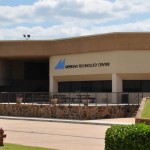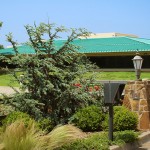Austin Short never imagined he’d have a career in imaging.
When he was in high school, Short enrolled in the Biomedical Sciences program at Meridian Technology Center, anticipating the STEM program’s advanced math and science courses and academic rigor would prepare him for pharmacy school.
And it did.
Following graduation, the Stillwater native moved to Weatherford to attend Southwestern Oklahoma State University. Two months in, he realized it wasn’t the path he wanted. Short began focusing on wrapping up his freshman year while simultaneously putting together a plan for his next steps.
As a part of that plan, he spent his spring break job shadowing a family member who works in radiography. After spending a week exploring the profession, he decided to return to Tech as a student in the school’s Radiologic Technology program.
“I just fell in love with it,” he said of his time in the imaging lab. “It solidified that this was what I needed to do.”
Over the two years he has spent in the program, Short’s passion has only grown.
Students in the program learn everything from patient care to using technology to produce diagnostic medical images. During their first year, they spend three days on campus, gaining a foundation in radiological sciences and health care. This includes anatomy, patient care, radiological procedures and an introduction to image analysis. The other two days are spent in the clinical setting working alongside radiologic technologists and gaining hands-on experience with patients. Students in the second year of the program spend three days in clinical practice and two days in the classroom, where they advance their knowledge and skills.
The field is a blend of art and science, and that’s something Short connected with.
“You have to have a complete understanding of the human body to know how to perfectly position a patient for the best image,” he explained. “If you don’t have the right placement, you could miss something critical.”
One element that Short has found both challenging and rewarding is working with patients to help them find comfort while they are being X-rayed.
“You never have a ‘perfect’ patient,” he said. “They generally come to you when they are injured, so it’s not always possible for them to be positioned in an ideal placement. You have to work with their limitations while finding ways to capture the images the radiologist needs for analysis.”
An unexpected obstacle in Short’s training was COVID-19.
“It’s hard to virtually learn something that’s truly hands-on, but our instructors did a tremendous job ensuring we were able to keep learning,” he said of the virtual learning experience. “Coursework moved online, and friends and family became our patients. It wasn’t ideal, but it worked. We were able to get our hours and meet the requirements for certification.”
When adult students returned to campus in June 2020, Short and his classmates quickly transitioned to spending time in the clinical setting. To make up for the missed time, students spent five days a week in the field.
“That actually had some perks. Not only did we get to see more patients, we also got an idea of what it will really be like when we’re on the job,” he rationalized.
Short has since been able to gain even more career experience. He has spent the last year working part time in Stillwater Medical’s walk-in clinics.
Short and his classmates will graduate on July 22 and then transition to working full-time for Stillwater Medical. He is scheduled to take his national certification test the following week.
“Let this be a lesson to everyone to keep your mind open and your options limitless,” he said. “You never know what your future holds or where your career plans can begin.”
Radiologic Technology at Tech
Technical skills are just part of what graduates take away from this hands-on program. Students learn how to communicate with patients, solve problems and work on a team with other health care professionals. Care and compassion are essential elements.
Upon successfully completing the educational and ethical requirements established by the American Registry of Radiologic Technologists (ARRT), students are prepared to take the national certification exam. The program is the foundation for employment in diagnostic radiography and computed tomography.
Qualified applicants must have completed a minimum of an associate degree or higher. Consideration may be given to applicants who are within 15 hours of degree completion. The degree must be completed before the completion of the radiologic technology program. The application process for the program begins February 1 each year and ends June 1. Because of the pre-requisites, potential students interested in fall 2022 admittance may need to start pre-requisites up to six months in advance.




Leave a Reply
You must be logged in to post a comment.